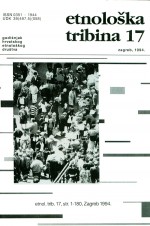Tradicije paljenja godišnjih vatri kao indikator kulturnih razlika
The Traditions of Lighting Fires during the Seasonal Festivities as an Indication of Cultural Differences
Author(s): Milana ČernelićContributor(s): Beatrice Mićunović (Translator)
Subject(s): Christian Theology and Religion, Customs / Folklore, Ethnohistory, Modern Age, Recent History (1900 till today), Cultural Anthropology / Ethnology, Identity of Collectives
Published by: Hrvatsko etnološko društvo
Keywords: lighting fires; seasonal festivities; tradition; cultural difference; Bunjevci; Šokci;
Summary/Abstract: The starting point of the study is to disclose the different traditions of seasonal fires the existence of which has been proved for the relatively narrow regions: North and North-Western regions of Bačka, among two Croatian groups traditionally known as Bunjevci and Šokci. According to historical data Šokci sealed into Slavonia, Srijem and Bačka primarily in the 16th and 17th century, in several migrational waves from Bosnia; Bunjevci settled in Bačka in the 17th century, having arrived presumably from Dalmatia and Hercegovina. The tradition of lighting fires in the eve of Easier among Šokci is primarily of the religious character. The fact that in the Šokci villages in the Bačka the embers of the fire are carried home in order to light the fire in own fireplaces indicates that this religious custom has adjusted well to the tradition, even becoming its integral part. The same and the similar customs (lighting the brought part of the wooden stick) are characteristical for the Catholic population of the eastern Pannonic plains, partly also known in the western parts, with isolated examples of the tradition in the Adriatic area and in the central Bosnia in the surrounding of Kreševo. The other tradition of burning Christmas straw among Šokci Croats in Bačka is regionally limited to the eastern Slavonia and Srijem in Croatia. Lighting bonfires on St. John’s day is the tradition of Bunjevci; it is a well-known tradition among the Croats as well as in the whole Europe. When dealing with the tradition among Bunjevci Croats in Bačka some specific features seem to be particularly interesting, such as the terms svitnjak and evilnjak denoting St. John’s fires. Both terms, especially svitnjak are widely used in the northern and central Dalmatian area, on the islands and in the Western Herzegovina, being also known in some southwestern and central areas of Bosnia. Two isolated examples of the term and its variant also appear in the southern Dalmatia and in the eastern Herzegovina. The analogies of the terms svitnjak and evitnjak in the expanse of Dalmatia, Herzegovina, in some regions of Bosnia and in the Bačka region among Bunjevci point to the ethnic and cultural kinship of their population. St. John’s bonfires rarely appear in Bosnia, while lighting torches on the occasion is quite common. One of the common terms for torches is mašala in the central Bosnian regions of the rivers Vrbas and Bosna. The same term is used for torch in one of the Bunjevci settlements in the Bačka region. The regions where the torches called mašala are used are bordering the regions of St. John’s bonfire called svitnjak. In two central Bosnian villages both terms appear, the term mašala for torch and the term svitnjak for the bonfire. Coincidences of the terms svitnjak or evitnjak for the St. John’s fire as well as of the specific term mašala for the torch point to the possible cultural and ethnic closeness of the population of the central Bosnian regions and some of the Bunjevci groups in the Bačka area. The result of the research of the St. John’s bonfires and torches is one more evidence for the already established fact, based on the analyses of wedding customs, that the cultural heritage of the Bunjevci groups in the Danube region is not quite unique. Finally, the author deals with the etymology of the term svitnjak. The analysis of the tradition of lighting annual bonfires has pointed out that the differences between two Croatian groups, traditionally known as Bunjevci and Šokci, are due to their different cultural, heritage.
Journal: Etnološka tribina : Godišnjak Hrvatskog etnološkog društva
- Issue Year: 24/1994
- Issue No: 17
- Page Range: 25-42
- Page Count: 18
- Language: Croatian

